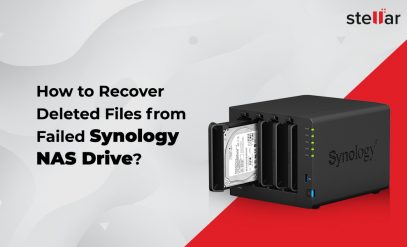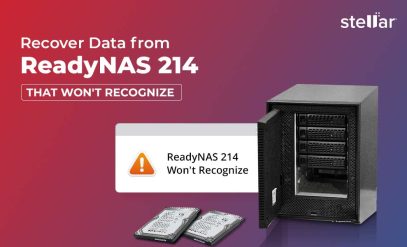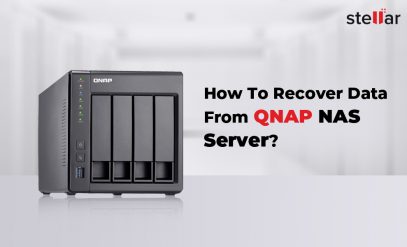| Summary: Sometimes, you lose data from your RAID-based NAS storage due to server failure, disks failure, etc. As data recovery from such storage devices is a complex task and requires expertise, you should seek the help of professional data recovery services to recover the data. |
|---|
NAS or Network-Attached Storage devices are high-capacity storage devices that allow you to connect to your home or mobile network to store and retrieve data from a central location. The NAS device allows authorized users to share and access files from any device connected to the network. It is similar to having a private cloud in your home or office.
इस पोस्ट को हिंदी में पढ़ने के लिए यहां क्लिक करें।
The best thing about the NAS device is that it can make use of technologies, like RAID (Redundant Array of Independent Disks). The RAID technology enables you to distribute and replicate your data, stored on NAS devices, over multiple hard drives. It implies that if one disk fails, the RAID system can copy the data to a new empty drive from the affected drive.
In simple terms, RAID is a storage technology that uses multiple disks for data redundancy, improved performance, or both. It is actually a configuration of multiple disks to work as a single unit. In fact, this technology creates a data loss fail-safe by merging different disks into an array.
RAID provides various configurations options to suit the specific requirements of an environment. The RAID configurations or levels, such as RAID 0, 1, 5, etc., are segregated based on the storage capacity, a minimum number of drives, data mirroring, and read-write performance. These levels of RAID offer fault tolerance, redundancy, performance, speed, security, and capacity required for the storage space.
However, the RAID-based NAS storage can also encounter data loss scenarios. You may lose data from the RAID-based NAS storage, due to controller failure, multiple drives failure, server crash, etc.
There could be many reasons that may result in RAID-based NAS storage failure, such as:
- Abrupt system shutdown
- A sudden power surge or outage
- Overheating
- Operating System errors
- Hardware failure
- Virus intrusion
- Incorrect setup
- Physical damage
RAID-based NAS storage device failure disturbs the complete disks arrangement. It is suggested to not attempt to correct things on your own. It may further complicate the situation. As a result, your mission-critical data will be at risk of loss. You can go through this case study and figure out how difficult it is to recover data from the RAID-based NAS storage device.
Once you encounter the RAID-based NAS failure, make sure to keep the following considerations in mind.
| Dos | Don’ts |
|---|---|
| Leave the system and NAS untouched once you encounter failure. | Don’t attempt to repair the damage on your own. |
| Approach the experienced RAID-based NAS storage data recovery expert immediately. | Don’t reach out to random inexperienced data recovery experts. |
How to Recover Data from RAID-based NAS Storage?
No doubt, the RAID-based NAS storage data recovery is a complicated task. Therefore, it is highly recommended to seek the help of an experienced data recovery services provider who has the expertise and complete know-how of RAID-based NAS servers. Stellar RAID data recovery services are the name you can trust for data recovery from RAID-based NAS storage.
The entity has profound experience in dealing with data loss cases related to RAID-based NAS storage devices. They use advanced technology and proprietary software to recover the data safely and securely. They perform the complicated data recovery task in the Class 100 Clean Room lab, which has a contamination-free, controlled environment required to open hard drives.
The data recovery experts at Stellar follow a specialized process to recover data from RAID-based NAS storage devices.
- First, the experts conduct a thorough analysis of the hard drives of the RAID-based NAS to find out the root cause of the issue.
- Then, the drives are opened in the Class 100 Clean Room lab. The lab technicians transplant the affected component of damaged hard drives if required.
- Then, the hard drives are cloned.
- Once the cloning process is completed, the virtual RAID is constructed using the RAID array logical parameters, such as configuration, data flow, strip size, and parity distribution.
- The next step is to scan the NAS drive image (data on NAS) thoroughly.
- Finally, the data is recovered safely.
The data recovery experts at Stellar follow stringent data privacy and security standards. They ensure complete data confidentiality, security, and privacy throughout the data recovery process.
Bottom Line
You may lose data from RAID-configured NAS storage due to multiple drives failure, controller failure, or any other reason. RAID-based NAS storage data recovery is a complicated process. It requires a detailed understanding of RAID configuration and years of experience in data recovery from NAS devices. Thus, be very cautious when choosing the data recovery services for your RAID-based NAS storage device. Stellar Data Recovery Services is a reliable and trusted name in the field of data recovery.
Related Blog Post: How to Recover Data from Western Digital My Book Live NAS Drive?







